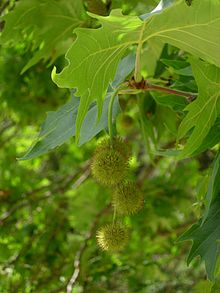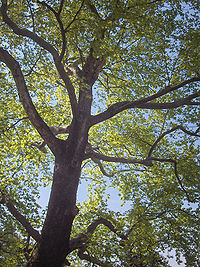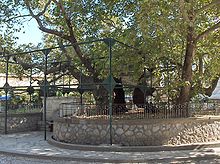- Platanus orientalis
-
Oriental Plane 
Fruits and leaves of Oriental plane Conservation status Scientific classification Kingdom: Plantae (unranked): Angiosperms (unranked): Eudicots Order: Proteales Family: Platanaceae Genus: Platanus Species: P. orientalis Binomial name Platanus orientalis
L.Platanus orientalis, or the Oriental plane, is a large, deciduous tree of the Platanaceae family, known for its longevity and spreading crown. The species name derives from its historical distribution eastward from the Balkans, where it was recognized in ancient Greek history and literature. Following Greek usage it is called Platane or related names in Europe. It was equally as famous to the Iranian-speaking world and from Turkey to India is called Chinar, Chenar or related names, following the Iranian. The native range of the Oriental plane is Eurasia from the Balkans to at least as far east as Iran. Some accounts extend its native range to Iberia in the west, and to the Himalaya in the east. As it has been known in cultivation from early times in much of this region, it can be difficult to determine if it is truly indigenous in peripheral areas.
Contents
Description
The oriental plane is found naturally in riverine settings, together with such trees as alder, willow and poplar. However, it is quite capable of survival and success in dry soils once it is established.
Like other plane trees, its leaves are borne alternately on the stem, deeply lobed, and palmate or maple-like. It usually has flaking bark, occasionally not flaking and becoming thick and rugged. Flowers and fruit are round and burr-like, borne in clusters of between 2 and 6 on a stem. Considerable variation exists among trees in the wild, and this may be complicated by crossbreeding with planted London planes (Platanus x hispanica), the hybrid of P. orientalis with the American sycamore (Platanus occidentalis).
The tree is capable of being grown in most temperate latitudes, though it benefits greatly from warm summers. As a very large and wide tree with broad, thick leaves that tend to orient horizontally, it is especially prized for the shade and coolness it provides during the hot season.
The leaves and bark have been used medicinally. A fabric dye has been made from the twigs and roots. The timber, often called lacewood, is figured and valuable for indoor furniture.
Cultural history
From earliest days, P. orientalis has been an important tree in Persian gardens, which are built around water and shade. There it is known as the chenar.
In historic Kashmir, the tree was planted near Hindu holy places under names derived from the goddess Bhavani. Later in Muslim times it continued to be a major garden and landscape tree and dominates many historic gardens,[1] now generally called chinar. For example, a famous landmark in Srinagar is an island on Dal Lake where four chinar trees stand, named Char Chinar. As another example, a 627-year-old chinar tree has been found at Chatargam, Chadoora, Badgam district, Kashmir. In repute it was planted in 1374 AD by an islamic mystic, Syed-Abul Qasim Shah Hamdani.[2]
Chinar trees are being felled rapidly in Kashmir,[3] although a recent ban has been enacted to curb cutting.[4] Chinar trees are now required to be registered and are considered National Property of the State. Registered Chinars are painted white at their base. Increased awareness means most old Chinars are protected and looked after; however, some new Chinars must be cut as their growth can cause damage to roads and houses. Most people now view the Chinar as a matter of national pride.
The Tree of Hippocrates, under which Hippocrates — the "Father of Medicine" — taught at Kos, is reputed to have been an oriental plane. A 500-year-old tree presently there may be on the same site and may have been planted from a succession of cuttings from the original. The Athenian Academy, outside Athens, featured a sacred grove of planes where the students listened to the masters and where among others the Peripatetics practiced philosophy.
Pliny's Natural History[5] records the westward progress of the plane "introduced among us from a foreign clime for nothing but its shade", planted first at the tomb of Diomedes on the island of Tremiti, then imported to Greek Sicily by Dionysius the Elder(c. 432-367 BC), tyrant of Syracuse. He had plane-trees conveyed to the city of Rhegium (Reggio di Calabria), where they were looked upon as the great marvel of his palace, according to Pliny's sources. From there it spread by the first century CE as far as the lands of the Morini in Belgic Gaul. Regardless of why it may have been introduced, the tree had medicinal uses from early times. Pliny[6] details 25 remedies using preparation from the bark, leaves and excrescences of plane. Some are still used: it stops bleeding and is used in eye ointment. Pliny prescribes it for burns, bites, stings, frost-bite and infections.[7]
Pliny goes on to describe some legendary plane-trees.[8] There was one on the grounds of the Athenian Academy, he says, that had roots 50 feet (15 m) long. Licinius Mucianus, legate of Lycia, held a banquet for 19 in a hollow plane-tree of Lycia, and the emperor Caligula another for 15 plus servants in a tree house (nest) built in the branches of a plane-tree at Velletri. Most small villages in Greece have one or more very old planes in their central square, where the village water spring used to be (water springs are nowadays replaced by water taps from the same spring captured). Many of them are set in cavities, which are often playing and meeting points for children and teenagers, or are cared for, sometimes even illuminated, as tourist attractions.
In 2011 a specimen planted by Capability Brown was identified as the tree with the greatest known spread in the United Kingdom.[9]
During the 2010 Commonwealth Games opening ceremony, the aerostat used took the shape of a chinar tree under the 'tree of knowledge' segment of the ceremony. This was followed by representation of different seasons through image projections and different dance styles being performed by hundreds of cultural dancers from all across India.Notes
- ^ Wanchoo, Pran Nath (2001-2002). "Chinar Tree, "Bouin" of Kashmir- Symbol of Goddess Bhawani". Vitasta XXXV. http://vitasta.org/2002/1.8.html.
- ^ Rajesh Bhat (2007-12-24). "627-year-old living legend found in Kashmir". Merinews.com. http://www.merinews.com/catFull.jsp?articleID=128596.
- ^ "Climate". Official Website of Anantag District. http://anantnag.gov.in/climate.htm.
- ^ "Ban on cutting Chinar trees in Kashmir". The Times of India. 5 March 2009. http://timesofindia.indiatimes.com/India/Ban-on-cutting-Chinar-trees-in-Kashmir/articleshow/4227201.cms.
- ^ XII.3.
- ^ XXIV.29
- ^ The details are omitted here. Caution: do not use any ancient remedies without consulting a physician.
- ^ XII.5
- ^ "Corsham Court Oriental plane 'most spreading tree in UK'". BBC News. 7-6-2011. http://www.bbc.co.uk/news/uk-england-wiltshire-13682775. Retrieved 7-6-2011.
References
- World Conservation Monitoring Centre (1998). Platanus orientalis. 2006. IUCN Red List of Threatened Species. IUCN 2006. www.iucnredlist.org. Retrieved on 10 May 2006.
External links
Categories:- IUCN Red List least concern species
- Platanaceae
- Ornamental trees
- Flora of Pakistan
- Least concern plants
Wikimedia Foundation. 2010.





